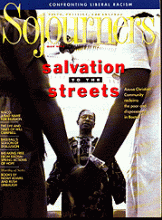This article is excerpted from Plundering Paradise: The Struggle for the Environment in the Philippines, by Robin Broad with John Cavanagh, University of California Press, April 1993.
Life is never easy for a Filipino peasant; but, decades ago, here in San Fernando, an old man tells us, "Food was plentiful. There was plenty of fish, plenty of corn, and plenty of rice."
Then, we are told, problems began to appear.
We are resting at a cluster of houses. It is late in the day and the peasants are returning home from their fields. A young mother, perhaps in her 20s, and an elderly couple do most of the talking.
For years, the younger woman explains, "ever since we started seeing big logging trucks" pass through San Fernando, the peasants watched the rivers change shape, turn muddier, less deep, yet more violent during the big rains. In formerly flood-free areas, the river would now overflow its banks, inundating adjacent fields with mud from the increasingly barren hills around them. And, the old man interjects, the river would sometimes even swallow the edges of the fertile fields along its side. In the last five years, one peasant who cultivated land on the banks of the Tigua lost nearly half of the land he had farmed.
There were other changes, too. Creeks nourished by once-forested watersheds disappeared during the dry season; landslides became common during the rainy season. And the rat population, which had previously found food in the forests and had been kept in check by forest predators, now ravaged farmers' fields at night. "People are hungry because the rats are eating everything," continues the young woman solemnly. Today, more than four out of five children suffer from some degree of malnutrition.
Read the Full Article

